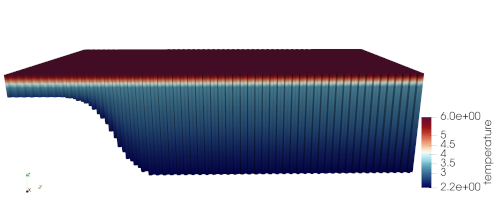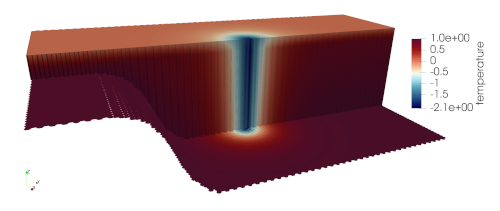ziso¶
The ocean/ziso test group implements variants of the Zonally Idealized
Southern Ocean (ZISO) test case from
Ringler et al. (2016). From that
paper:
The test case is zonally uniform with respect to all boundary conditions and forcing. The 1000 km spanned in the zonal direction \(L_x\) is periodic, and the 2000 km spanned in the meridional direction \(L_y\) is bounded by walls with a no-slip boundary condition.
The bathymetry \(h(y)\) is specified as:
\[h(y) = H_s + \frac{1}{2}(H - H_s)\left[1 + \mathrm{tanh}\left( \frac{y - Y_s}{W_s}\right)\right],\]where \(H = 2500\) m is the maximum depth, \(H_s = 500\) m is the shelf depth, \(Y_s = 250\) km is the center y position of the shelf, and \(W_s = 500\) km is the center y position of the shelf break.
See that paper for more details on the test case.
The implementation of ziso in compass includes two test cases,
default and with_frazil. Both test cases have 2 steps,
initial_state, which defines the mesh and initial conditions for the model,
and forward, which performs time integration of the model.
Currently, the only version of the test case is at 20-km horizontal resolution, but versions of the test case at finer horizontal resolution are expected to be ported form Legacy COMPASS in the coming months.
default¶
ocean/ziso/20km/default is the default version of the ZISO
test case from Ringler et al. (2016).
The default test case also includes particles from the Lagrangian, in Situ,
Global, High-Performance Particle Tracking (LIGHT;
Wolfram et al. 2015) framework.
The initial salinity is constant at 34 PSU and the initial temperature is warm at the surface and cooler at depth:

The test case includes a very short (3 time step) test run and validation of prognostic and particle-relate variables for regression testing.
long¶
Results in Ringler et al. (2016) are shown from longer simulations. The
ocean/ziso/<resolution>/long test cases provide a variant on these original
simulations. As in the default test, this test not include particle
dynamics. Unlike default, this test case is configured for a longer
simulation (10 day) that demonstrates how to use the configuration might be
used for for scientific work.
particles¶
These ZISO test cases include particles from the Lagrangian, In situ, Global,
High-Performance Particle Tracking (LIGHT) framework for regression testing.
Otherwise, the particles tests are identical to default.
Particle-relate variables are also included in the test-case validation.
with_frazil¶
ocean/ziso/20km/with_frazil uses an different initial
temperature field that is cold enough to produce frazil ice:

The config options that control this initial state are:
# namelist options for Zonally periodic Idealized Southern Ocean (ZISO)
# testcases
[ziso]
# Initial temperature profile constant
initial_temp_t1 = 0.0
# Initial temperature profile tanh coefficient
initial_temp_t2 = -1.0
# Initial temperature profile tanh length scale
initial_temp_h1 = 300.0
# Initial temperature profile linear coefficient
initial_temp_mt = 0.0
MPAS-Ocean’s capability for producing frazil ice is enabled in this test case, whereas this test case does not include lagrangian particles from LIGHT.
The test case includes a very short (1 min 30 sec) test run, the results of which are used to check prognostic and frazil-related variables during regression testing.